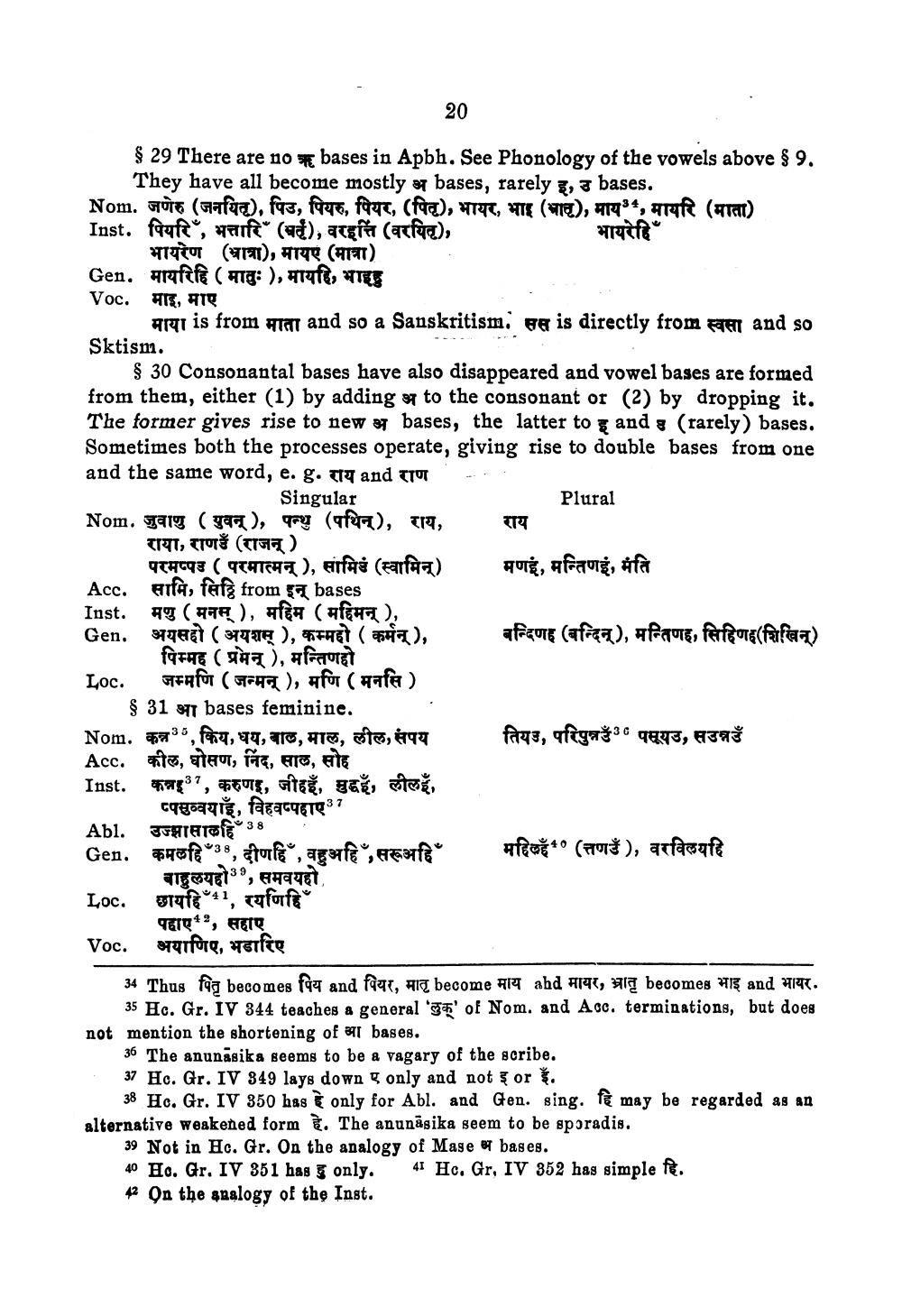________________
20
भायरेहि
$ 29 There are no #bases in Apbh. See Phonology of the vowels above $9.
They have all become mostly अ bases, rarely इ, उ bases. Nom. जणेरु (जनयित), पिउ, पियरु, पियर, (पित्), भायर, भाइ (भा), माय 4, मायरि (माता) Inst. पियरि , भत्तारि (भर्तृ), वरइत्ति (वरयित्),
भायरेण (भ्राता), मायए (मात्रा) Gen. मायरिहि (मातुः),मायहि भाइह Voc. माइ, माए
माया is from माता and so a Sanskritism: Rais directly from स्वसा and so Sktism.
$ 30 Consonantal bases have also disappeared and vowel bases are formed from them, either (1) by adding 97 to the consonant or (2) by dropping it. The former gives rise to new 37 bases, the latter to g and ? (rarely) bases. Sometimes both the processes operate, giving rise to double bases from one and the same word, e.g. राय and राण ... Singular
Plural Nom. जुवाणु (युवन्), पन्धु (पथिन), राय, राय
राया, राणउँ (राजन)
परमप्पउ (परमात्मन् ), सामिङ (स्वामिन्) मणई, मन्तिणई, मंति Acc. सामि, सिठ्ठि from इन् bases Inst. मणु (मनस् ), महिम (महिमन् ), Gen. अयसहो (अयशस् ), कम्महो ( कर्मन्), बन्दिणह (बन्दिन्), मन्तिणह, सिहिणह(शिखिन्)
पिम्मह (प्रमेन् ), मन्तिणहो Loc. जम्मणि (जन्मन् ), मणि (मनसि)
$ 31 917 bases feminine. Nom. कन्न, किय, धय, बाल, माल, लील,संपय तियउ, परिपुत्रउँ पसूयउ, सउन्नउँ Acc. कील, घोसण, निंद, साल, सोह Inst. कन्नई, करुणइ, जीहइँ, मुद्दइँ, लील,
प्पसुव्वयाइँ, विहवप्पहाए37 Abl. उज्झासालहि 38 . Gen. कमलहि*39, दीणहि , वहुअहि ,सरूअहि. महिलहँ' (त्तणउँ), वरविलयहि
बाहुलयहो, समवयहो, Loc. छायहि 41, रणिहि
पहाए, सहाए Voc. अयाणिए, भडारिए
34 Thus पितृ becomes पिय and पियर, मातृ become माय ahd मायर, भ्रातृ becomes भाइ and भायर.
35 Hc. Gr. IV 344 teaches ageneral 'लुक' of Nom. and Acc. terminations, but does not mention the shortening of a bases.
36 The anunasikaseems to be a vagary of the scribe. 37 Hc. Gr. IV 349 lays down ए only and not or इ.
38 Hc. Gr. IV 350 has only for Abl. and Gen. sing. te may be regarded as an alternative weakened form ? The anunāsika seem to be sporadis.
39 Not in Hc. Gr. On the analogy of Mase e bases. 40 Ho. Gr. IV 351 has only. 41 Hc. Gr, IV 352 has simple fe. 42 On the analogy of the Inst.




